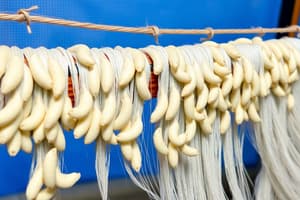Podcast
Questions and Answers
Why is silk known as the 'Queen of Textiles'?
Why is silk known as the 'Queen of Textiles'?
- Due to its affordability and widespread availability
- Because it is the most durable textile material
- Because of its coarse and uneven texture
- For its association with elegance, class, and comfort (correct)
What is the significance of the cocoon stage in the life cycle of a silkworm?
What is the significance of the cocoon stage in the life cycle of a silkworm?
- It allows the silkworm to transform into a pupa for further development (correct)
- It is where the silkworm consumes large amounts of mulberry leaves
- It marks the beginning of the life cycle of a silk moth
- It is where the silk moth lays its eggs for future generations
Why does the caterpillar secrete a fibre made of proteins during the cocoon stage?
Why does the caterpillar secrete a fibre made of proteins during the cocoon stage?
- To protect itself from predators in the environment
- To build a nest for its offspring
- To form a protective covering for its transformation into a pupa (correct)
- To attract mates for reproduction
Where did the use of silk as a fibre originate?
Where did the use of silk as a fibre originate?
What type of animal fibre is silk?
What type of animal fibre is silk?
What does silk production involve?
What does silk production involve?
What is the name of the most common silk moth mentioned in the text?
What is the name of the most common silk moth mentioned in the text?
What is the process of obtaining adult silk thread from a cocoon?
What is the process of obtaining adult silk thread from a cocoon?
What is the term for the occupation of rearing silkworms?
What is the term for the occupation of rearing silkworms?
What does the pupa transform into in the life cycle of a silk moth?
What does the pupa transform into in the life cycle of a silk moth?
What do female moths lay after mating?
What do female moths lay after mating?
Flashcards are hidden until you start studying
Study Notes
Life Cycle of a Silk Moth
- A silk moth's life cycle consists of four stages: egg, larva (silkworm), pupa, and adult moth.
- The female silk moth lays eggs, from which larvae hatch and grow into caterpillars or silkworms.
The Cocoon Stage
- The caterpillar secretes a fibre made of proteins called 'fibroin' and 'sericine' to form a cocoon.
- The fibre hardens on exposure to air and becomes a silk fibre, completely covering the caterpillar.
- The pupa continues to develop inside the cocoon, eventually emerging as a moth.
Production of Silk
- The silk yarn is obtained from the cocoon of the silk moth.
- Different types of silk moths produce silk yarn with varying textures (coarse, smooth, shiny, etc.).
- Adult silk thread is obtained by unwinding the cocoon and then woven into silk cloth.
Sericulture
- 'Sericulture' or the culture of silkworms is a very old occupation in India.
- The most common silk moth is the mulberry silk moth (Bombyx mori), which produces soft, lustrous, and elastic silk fibre.
Characteristics of Silk
- Silk is known as the 'Queen of Textiles' due to its elegance, class, and comfort.
- Silk is a type of animal fibre produced by a moth called the silk moth.
History of Silk Production
- The use of silk as a fibre originated in China.
- There are various types of silk, such as Tassar silk, Mooga silk, and Kosa silk, obtained from cocoons spun by different types of moths.
Studying That Suits You
Use AI to generate personalized quizzes and flashcards to suit your learning preferences.




